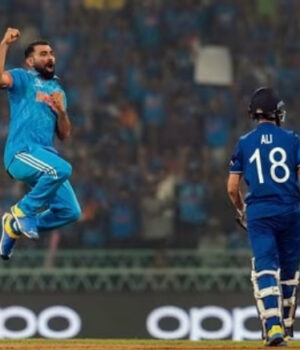In the ever-evolving landscape of international cricket, team balance is often the key to success. The return of Mohammed Shami to India’s lineup, following a period of absence, has sent a resounding message to the cricketing world – India’s formidable sixth-bowling option is back. This revelation serves as a warning to opposing teams, rekindling the discussions surrounding India’s pre-World Cup concerns.
Intriguingly, this discussion gained momentum when videos surfaced on social media, showcasing Virat Kohli and Shubman Gill casually rolling their arms during a net session in Lucknow, just two days before their clash against England. While these instances may have initially raised questions about India’s quest for an additional all-rounder, the situation seemed to stabilize after their convincing victory over Bangladesh in Pune a week ago.
However, just as the fears of team balance seemed to vanish into the oblivion, they resurfaced with the untimely ankle injury to Hardik Pandya. With no definitive confirmation regarding his return, India found themselves in a predicament, set to play six more matches before the World Cup. The pertinent question now looms – how do you replace a fast-bowling all-rounder of Hardik Pandya’s stature? Should India opt for an extra batter or bolster their bowling resources?
The dilemma of replacing a player of Hardik Pandya’s caliber is multifaceted. His dynamic presence in the team not only provides an explosive batting option but also offers crucial overs with the ball. Finding a like-for-like replacement is a challenging task that requires a careful evaluation of available options.
One possible approach is to consider strengthening the batting lineup. In a format as competitive as T20, having an extra quality batsman can be a game-changer. This approach would allow India to maintain their formidable batting depth, which has been a significant strength in recent years. However, this strategy may put additional pressure on the remaining bowlers to cover the overs that Pandya would typically provide.
Conversely, another path to explore is bolstering the bowling department. Investing in a specialist bowler would provide India with an additional wicket-taking option and potentially alleviate the workload on the existing bowlers. This approach, while addressing the bowling concerns, might slightly compromise the batting firepower, depending on the player selected.
The key to India’s decision lies in striking a balance between these two aspects. Team management, along with the think tank, must carefully weigh the pros and cons of each option. Factors such as pitch conditions, opposition strengths, and the overall team strategy will play a pivotal role in making this crucial decision.
The return of Mohammed Shami is undoubtedly a positive sign for India, but the Hardik Pandya-shaped void in the team remains a challenge that needs a strategic solution. As India marches ahead in their T20 World Cup campaign, the decision they make regarding this critical matter will significantly influence their prospects in the tournament.
In the unpredictable world of T20 cricket, team balance can make all the difference. India’s quest for equilibrium continues, and the choice between an extra batter or a bowler could shape their journey towards World Cup glory.










